Design Thinking for Managers: Personal Reflection Report - T2 2019
VerifiedAdded on 2022/10/10
|22
|6178
|203
Report
AI Summary
This report provides a comprehensive reflection on the application of design thinking for managers, covering various aspects of the design process and personal development. The report begins with an overview of design thinking and its importance in creative decision-making, followed by a weekly reflection detailing the author's learning journey. Each week focuses on different aspects of design thinking, including the design process, design theory, problem-finding, needs analysis, ethics, rapid prototyping, and project launch. The report highlights key concepts such as visualization, design logic, interpretivism, brainstorming, journey mapping, ethics in research, rapid prototyping techniques, and the elements of a successful learning launch. An action plan is included, which addresses key development needs and identifies specific activities for implementation. The report demonstrates the author's growth in understanding and applying design thinking principles, supported by references and appendices that include weekly blog entries. The author demonstrates a strong understanding of design thinking principles and their application in a management context.
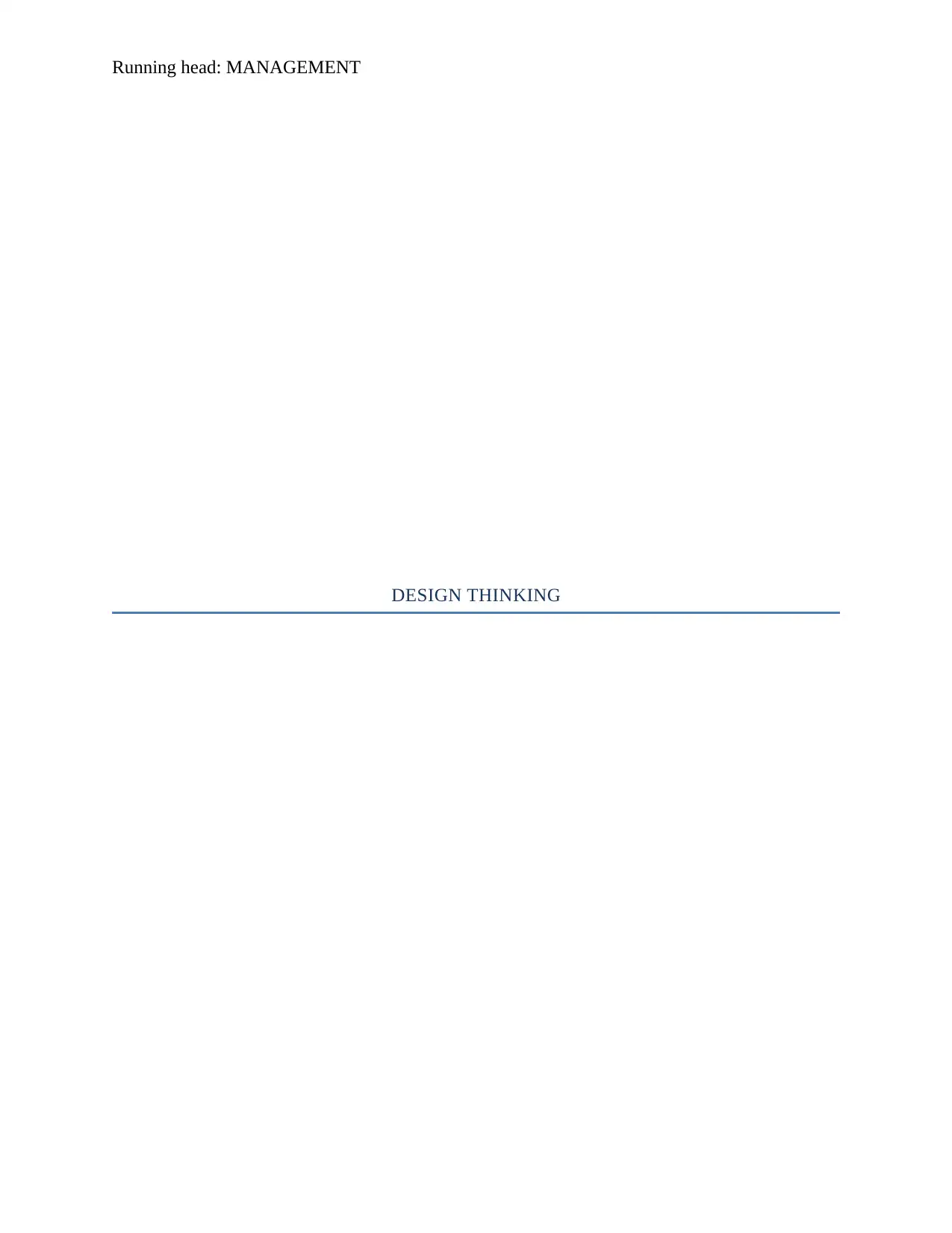
Running head: MANAGEMENT
DESIGN THINKING
DESIGN THINKING
Paraphrase This Document
Need a fresh take? Get an instant paraphrase of this document with our AI Paraphraser
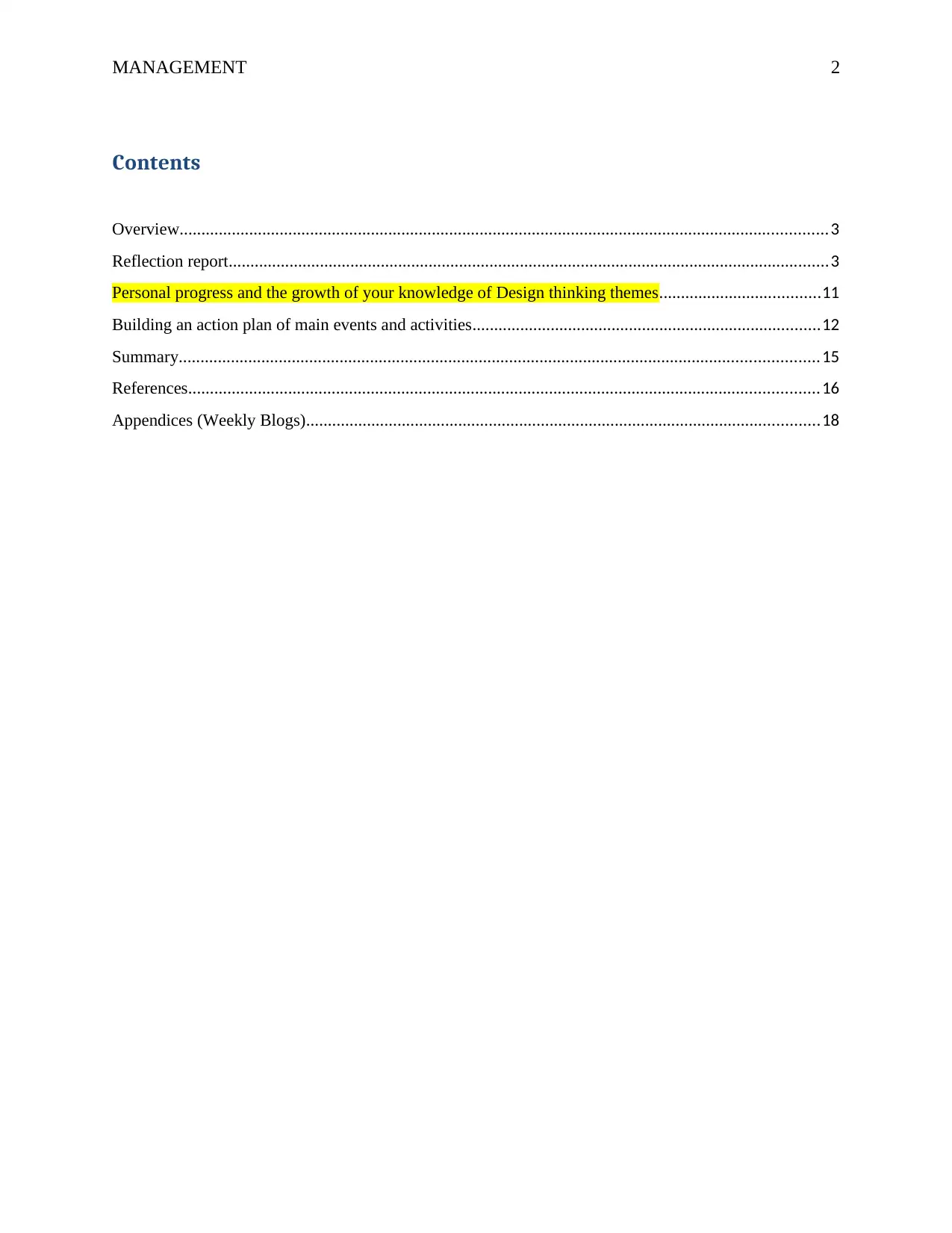
MANAGEMENT 2
Contents
Overview.....................................................................................................................................................3
Reflection report..........................................................................................................................................3
Personal progress and the growth of your knowledge of Design thinking themes.....................................11
Building an action plan of main events and activities................................................................................12
Summary...................................................................................................................................................15
References.................................................................................................................................................16
Appendices (Weekly Blogs)......................................................................................................................18
Contents
Overview.....................................................................................................................................................3
Reflection report..........................................................................................................................................3
Personal progress and the growth of your knowledge of Design thinking themes.....................................11
Building an action plan of main events and activities................................................................................12
Summary...................................................................................................................................................15
References.................................................................................................................................................16
Appendices (Weekly Blogs)......................................................................................................................18

MANAGEMENT 3
Overview
In present scenario, design thinking is used by managers for making creative decision. Design
management has conventionally practiced design thinking approach for developing compelling
products and services, which encourages the consumers, constantly developing financial rewards
as well as, developing the brand loyalty (Glen, Suciu, &Baughn, 2014). This report presents the
weekly reflection on design thinking for managers. It also demonstrates the blogs on activities
that I have done in each week.
Reflection report
Week 1: Introduction to Design Thinking
In this week, I have built my understanding related to design thinking. Continuing this, I have
learned that design thinking is an important way to deal with multifaceted and vague issues. It is
also observed that design thinking isa creativeproblem-solving strategy that designers could use
for developing new values that are different as well as, develops positive impact (sources: blog
1). During this week, I have built my knowledge in relation with visualization. In such a manner,
I have learned that visualization could use imagery for envision possibilities as well as, convey
them to life (Liedtka& Ogilvie, 2011). I would like to apply my learning in the future in terms of
making creative design thinking.
Week 2: Design Process Workshop
During this time, I have learned various concepts about design process. This process includes
empathizing, define, ideate, prototype, and test. It can be broken down into design thinking tools
that can help in innovation. I have also improved my knowledge of another process of design
thinking. These includes analysis of value chain, journey mapping, visualization, mind mapping,
concept progress, assumption trying, fast prototyping and consumer co-creation. I have also
Overview
In present scenario, design thinking is used by managers for making creative decision. Design
management has conventionally practiced design thinking approach for developing compelling
products and services, which encourages the consumers, constantly developing financial rewards
as well as, developing the brand loyalty (Glen, Suciu, &Baughn, 2014). This report presents the
weekly reflection on design thinking for managers. It also demonstrates the blogs on activities
that I have done in each week.
Reflection report
Week 1: Introduction to Design Thinking
In this week, I have built my understanding related to design thinking. Continuing this, I have
learned that design thinking is an important way to deal with multifaceted and vague issues. It is
also observed that design thinking isa creativeproblem-solving strategy that designers could use
for developing new values that are different as well as, develops positive impact (sources: blog
1). During this week, I have built my knowledge in relation with visualization. In such a manner,
I have learned that visualization could use imagery for envision possibilities as well as, convey
them to life (Liedtka& Ogilvie, 2011). I would like to apply my learning in the future in terms of
making creative design thinking.
Week 2: Design Process Workshop
During this time, I have learned various concepts about design process. This process includes
empathizing, define, ideate, prototype, and test. It can be broken down into design thinking tools
that can help in innovation. I have also improved my knowledge of another process of design
thinking. These includes analysis of value chain, journey mapping, visualization, mind mapping,
concept progress, assumption trying, fast prototyping and consumer co-creation. I have also
⊘ This is a preview!⊘
Do you want full access?
Subscribe today to unlock all pages.

Trusted by 1+ million students worldwide
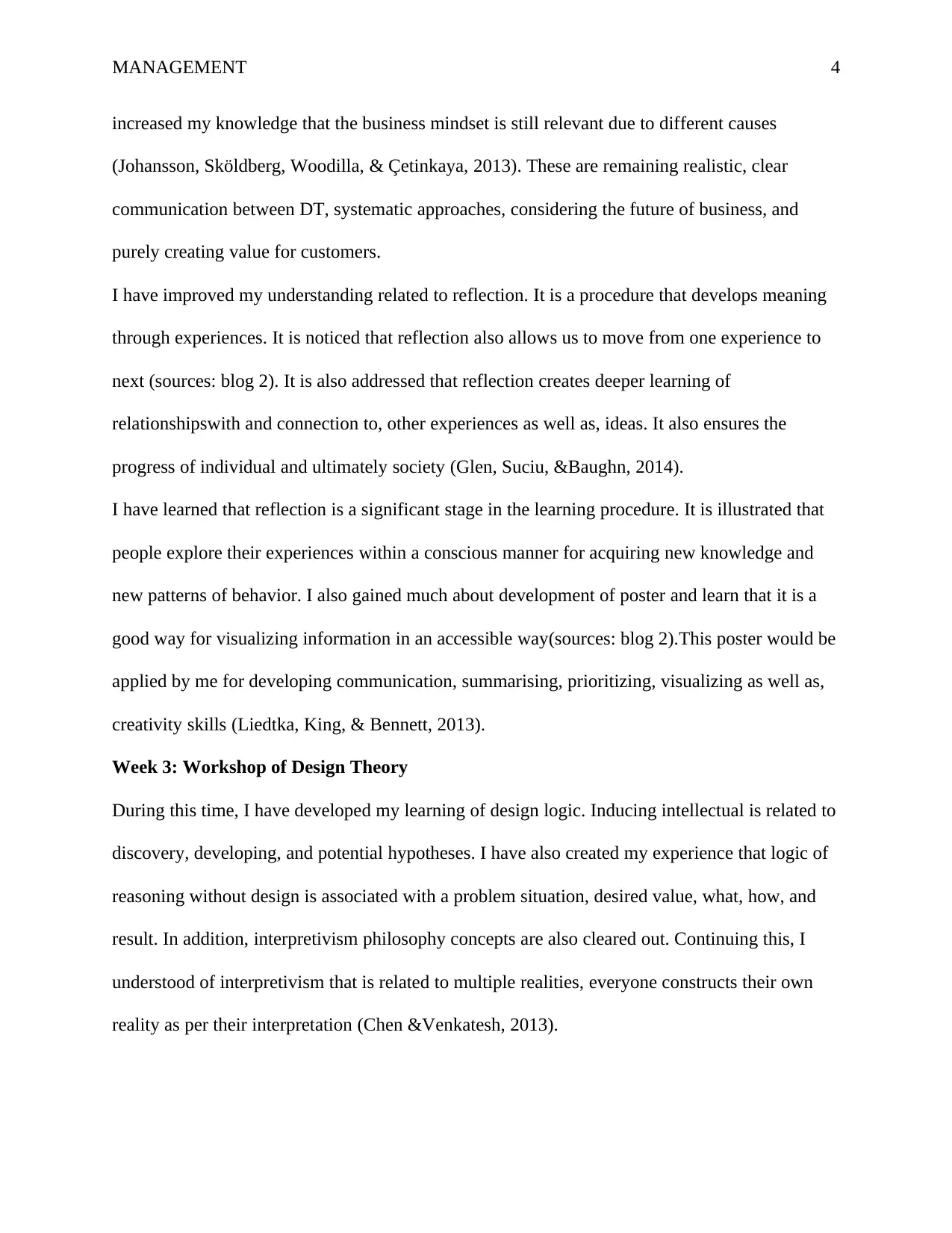
MANAGEMENT 4
increased my knowledge that the business mindset is still relevant due to different causes
(Johansson, Sköldberg, Woodilla, & Çetinkaya, 2013). These are remaining realistic, clear
communication between DT, systematic approaches, considering the future of business, and
purely creating value for customers.
I have improved my understanding related to reflection. It is a procedure that develops meaning
through experiences. It is noticed that reflection also allows us to move from one experience to
next (sources: blog 2). It is also addressed that reflection creates deeper learning of
relationshipswith and connection to, other experiences as well as, ideas. It also ensures the
progress of individual and ultimately society (Glen, Suciu, &Baughn, 2014).
I have learned that reflection is a significant stage in the learning procedure. It is illustrated that
people explore their experiences within a conscious manner for acquiring new knowledge and
new patterns of behavior. I also gained much about development of poster and learn that it is a
good way for visualizing information in an accessible way(sources: blog 2).This poster would be
applied by me for developing communication, summarising, prioritizing, visualizing as well as,
creativity skills (Liedtka, King, & Bennett, 2013).
Week 3: Workshop of Design Theory
During this time, I have developed my learning of design logic. Inducing intellectual is related to
discovery, developing, and potential hypotheses. I have also created my experience that logic of
reasoning without design is associated with a problem situation, desired value, what, how, and
result. In addition, interpretivism philosophy concepts are also cleared out. Continuing this, I
understood of interpretivism that is related to multiple realities, everyone constructs their own
reality as per their interpretation (Chen &Venkatesh, 2013).
increased my knowledge that the business mindset is still relevant due to different causes
(Johansson, Sköldberg, Woodilla, & Çetinkaya, 2013). These are remaining realistic, clear
communication between DT, systematic approaches, considering the future of business, and
purely creating value for customers.
I have improved my understanding related to reflection. It is a procedure that develops meaning
through experiences. It is noticed that reflection also allows us to move from one experience to
next (sources: blog 2). It is also addressed that reflection creates deeper learning of
relationshipswith and connection to, other experiences as well as, ideas. It also ensures the
progress of individual and ultimately society (Glen, Suciu, &Baughn, 2014).
I have learned that reflection is a significant stage in the learning procedure. It is illustrated that
people explore their experiences within a conscious manner for acquiring new knowledge and
new patterns of behavior. I also gained much about development of poster and learn that it is a
good way for visualizing information in an accessible way(sources: blog 2).This poster would be
applied by me for developing communication, summarising, prioritizing, visualizing as well as,
creativity skills (Liedtka, King, & Bennett, 2013).
Week 3: Workshop of Design Theory
During this time, I have developed my learning of design logic. Inducing intellectual is related to
discovery, developing, and potential hypotheses. I have also created my experience that logic of
reasoning without design is associated with a problem situation, desired value, what, how, and
result. In addition, interpretivism philosophy concepts are also cleared out. Continuing this, I
understood of interpretivism that is related to multiple realities, everyone constructs their own
reality as per their interpretation (Chen &Venkatesh, 2013).
Paraphrase This Document
Need a fresh take? Get an instant paraphrase of this document with our AI Paraphraser
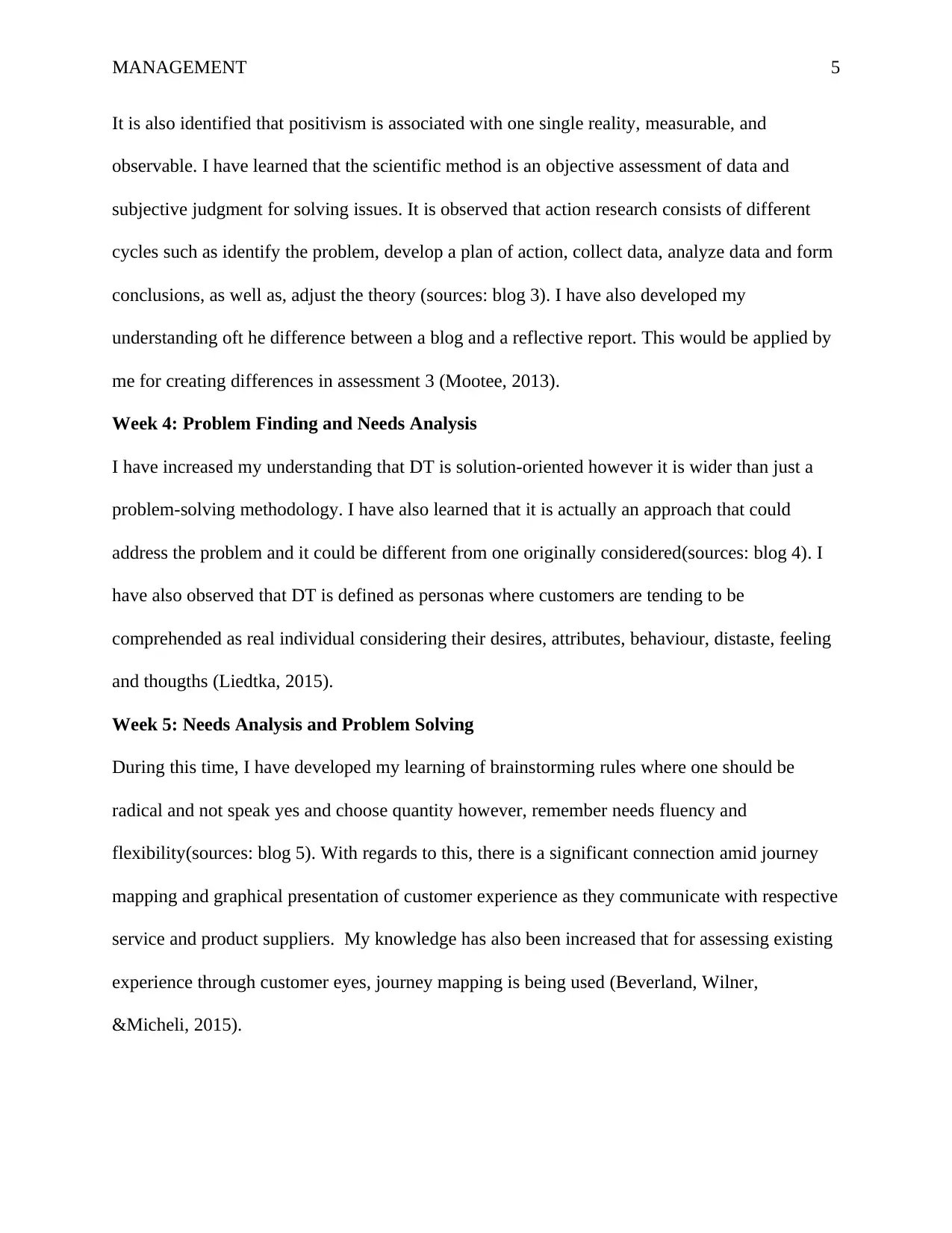
MANAGEMENT 5
It is also identified that positivism is associated with one single reality, measurable, and
observable. I have learned that the scientific method is an objective assessment of data and
subjective judgment for solving issues. It is observed that action research consists of different
cycles such as identify the problem, develop a plan of action, collect data, analyze data and form
conclusions, as well as, adjust the theory (sources: blog 3). I have also developed my
understanding oft he difference between a blog and a reflective report. This would be applied by
me for creating differences in assessment 3 (Mootee, 2013).
Week 4: Problem Finding and Needs Analysis
I have increased my understanding that DT is solution-oriented however it is wider than just a
problem-solving methodology. I have also learned that it is actually an approach that could
address the problem and it could be different from one originally considered(sources: blog 4). I
have also observed that DT is defined as personas where customers are tending to be
comprehended as real individual considering their desires, attributes, behaviour, distaste, feeling
and thougths (Liedtka, 2015).
Week 5: Needs Analysis and Problem Solving
During this time, I have developed my learning of brainstorming rules where one should be
radical and not speak yes and choose quantity however, remember needs fluency and
flexibility(sources: blog 5). With regards to this, there is a significant connection amid journey
mapping and graphical presentation of customer experience as they communicate with respective
service and product suppliers. My knowledge has also been increased that for assessing existing
experience through customer eyes, journey mapping is being used (Beverland, Wilner,
&Micheli, 2015).
It is also identified that positivism is associated with one single reality, measurable, and
observable. I have learned that the scientific method is an objective assessment of data and
subjective judgment for solving issues. It is observed that action research consists of different
cycles such as identify the problem, develop a plan of action, collect data, analyze data and form
conclusions, as well as, adjust the theory (sources: blog 3). I have also developed my
understanding oft he difference between a blog and a reflective report. This would be applied by
me for creating differences in assessment 3 (Mootee, 2013).
Week 4: Problem Finding and Needs Analysis
I have increased my understanding that DT is solution-oriented however it is wider than just a
problem-solving methodology. I have also learned that it is actually an approach that could
address the problem and it could be different from one originally considered(sources: blog 4). I
have also observed that DT is defined as personas where customers are tending to be
comprehended as real individual considering their desires, attributes, behaviour, distaste, feeling
and thougths (Liedtka, 2015).
Week 5: Needs Analysis and Problem Solving
During this time, I have developed my learning of brainstorming rules where one should be
radical and not speak yes and choose quantity however, remember needs fluency and
flexibility(sources: blog 5). With regards to this, there is a significant connection amid journey
mapping and graphical presentation of customer experience as they communicate with respective
service and product suppliers. My knowledge has also been increased that for assessing existing
experience through customer eyes, journey mapping is being used (Beverland, Wilner,
&Micheli, 2015).
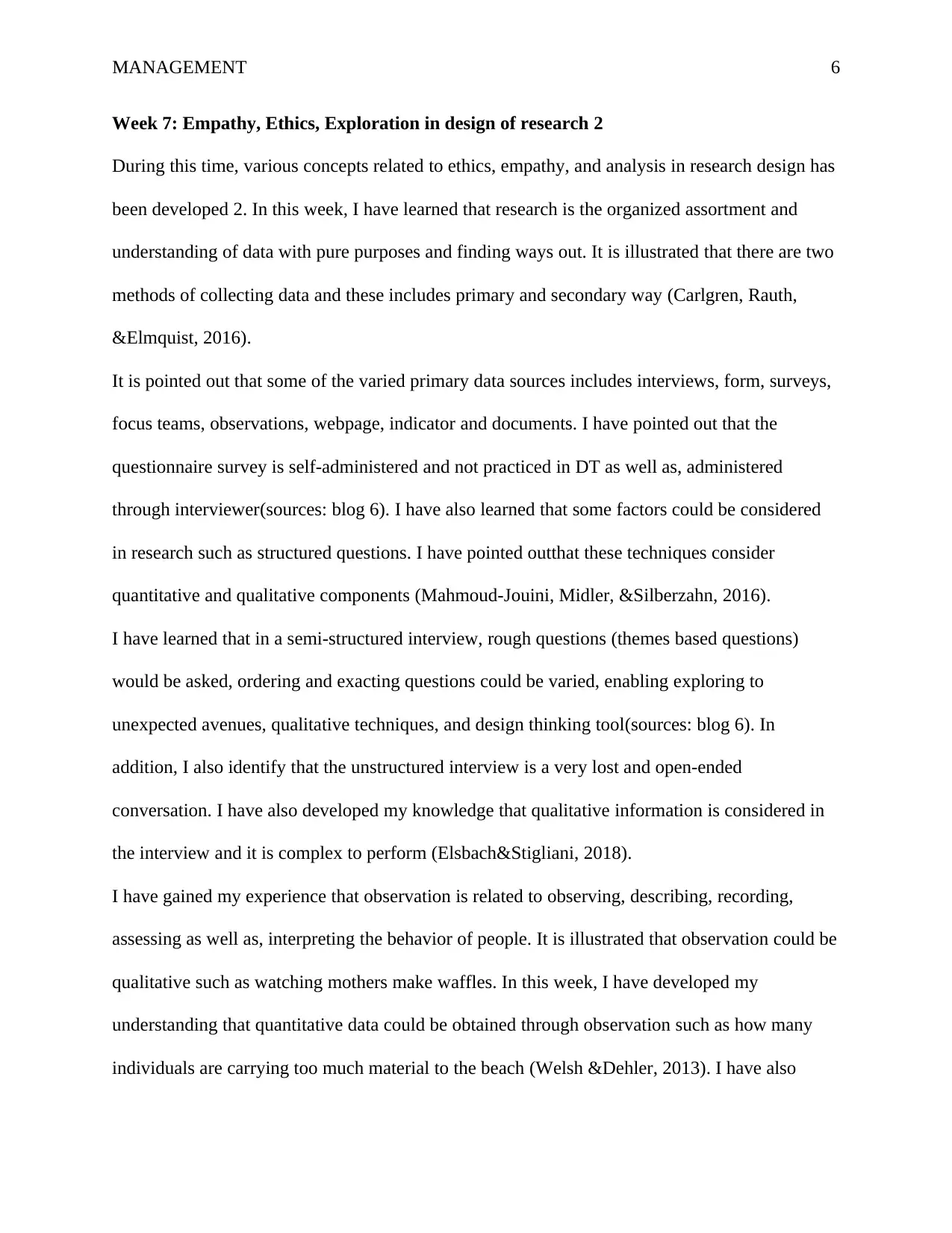
MANAGEMENT 6
Week 7: Empathy, Ethics, Exploration in design of research 2
During this time, various concepts related to ethics, empathy, and analysis in research design has
been developed 2. In this week, I have learned that research is the organized assortment and
understanding of data with pure purposes and finding ways out. It is illustrated that there are two
methods of collecting data and these includes primary and secondary way (Carlgren, Rauth,
&Elmquist, 2016).
It is pointed out that some of the varied primary data sources includes interviews, form, surveys,
focus teams, observations, webpage, indicator and documents. I have pointed out that the
questionnaire survey is self-administered and not practiced in DT as well as, administered
through interviewer(sources: blog 6). I have also learned that some factors could be considered
in research such as structured questions. I have pointed outthat these techniques consider
quantitative and qualitative components (Mahmoud-Jouini, Midler, &Silberzahn, 2016).
I have learned that in a semi-structured interview, rough questions (themes based questions)
would be asked, ordering and exacting questions could be varied, enabling exploring to
unexpected avenues, qualitative techniques, and design thinking tool(sources: blog 6). In
addition, I also identify that the unstructured interview is a very lost and open-ended
conversation. I have also developed my knowledge that qualitative information is considered in
the interview and it is complex to perform (Elsbach&Stigliani, 2018).
I have gained my experience that observation is related to observing, describing, recording,
assessing as well as, interpreting the behavior of people. It is illustrated that observation could be
qualitative such as watching mothers make waffles. In this week, I have developed my
understanding that quantitative data could be obtained through observation such as how many
individuals are carrying too much material to the beach (Welsh &Dehler, 2013). I have also
Week 7: Empathy, Ethics, Exploration in design of research 2
During this time, various concepts related to ethics, empathy, and analysis in research design has
been developed 2. In this week, I have learned that research is the organized assortment and
understanding of data with pure purposes and finding ways out. It is illustrated that there are two
methods of collecting data and these includes primary and secondary way (Carlgren, Rauth,
&Elmquist, 2016).
It is pointed out that some of the varied primary data sources includes interviews, form, surveys,
focus teams, observations, webpage, indicator and documents. I have pointed out that the
questionnaire survey is self-administered and not practiced in DT as well as, administered
through interviewer(sources: blog 6). I have also learned that some factors could be considered
in research such as structured questions. I have pointed outthat these techniques consider
quantitative and qualitative components (Mahmoud-Jouini, Midler, &Silberzahn, 2016).
I have learned that in a semi-structured interview, rough questions (themes based questions)
would be asked, ordering and exacting questions could be varied, enabling exploring to
unexpected avenues, qualitative techniques, and design thinking tool(sources: blog 6). In
addition, I also identify that the unstructured interview is a very lost and open-ended
conversation. I have also developed my knowledge that qualitative information is considered in
the interview and it is complex to perform (Elsbach&Stigliani, 2018).
I have gained my experience that observation is related to observing, describing, recording,
assessing as well as, interpreting the behavior of people. It is illustrated that observation could be
qualitative such as watching mothers make waffles. In this week, I have developed my
understanding that quantitative data could be obtained through observation such as how many
individuals are carrying too much material to the beach (Welsh &Dehler, 2013). I have also
⊘ This is a preview!⊘
Do you want full access?
Subscribe today to unlock all pages.

Trusted by 1+ million students worldwide
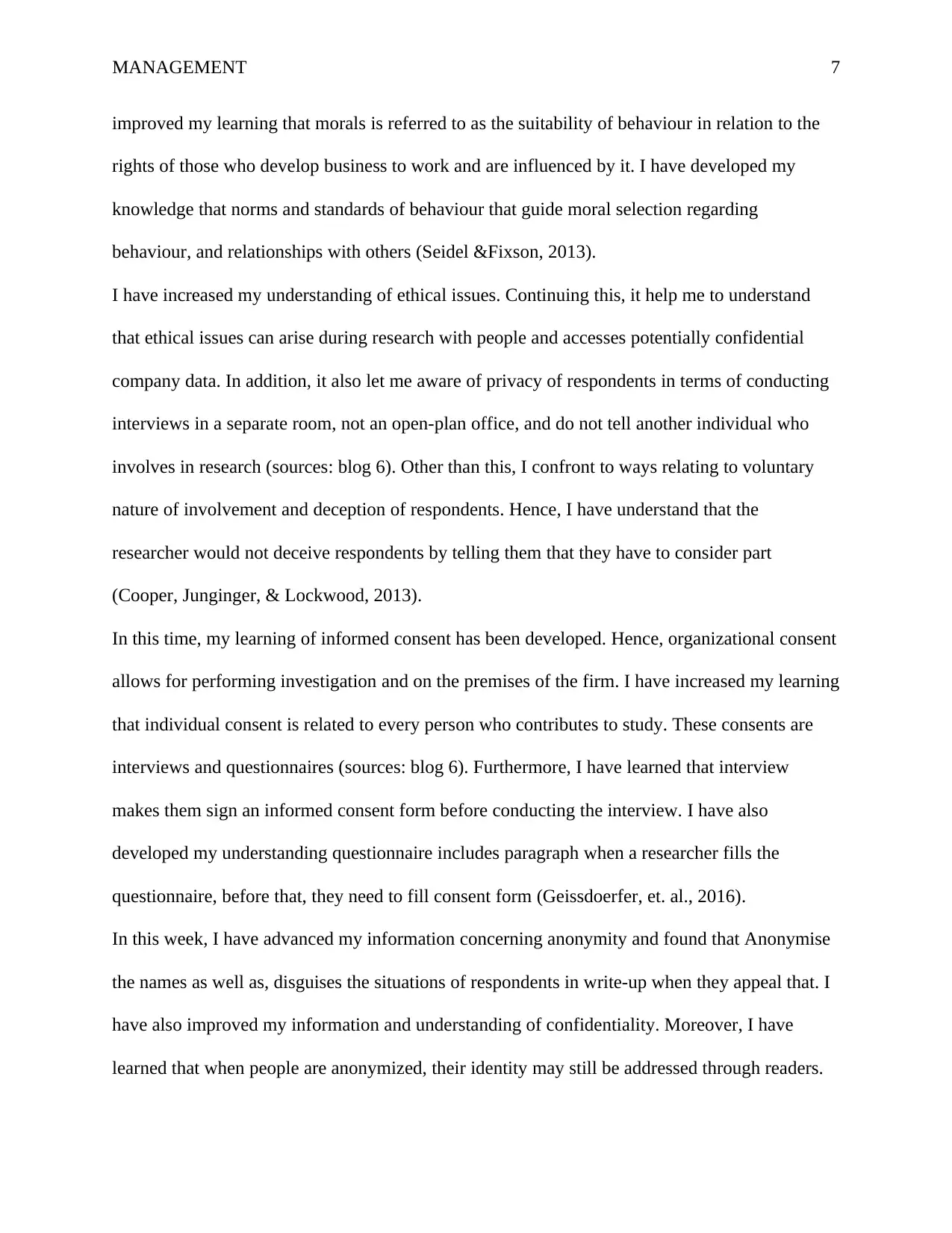
MANAGEMENT 7
improved my learning that morals is referred to as the suitability of behaviour in relation to the
rights of those who develop business to work and are influenced by it. I have developed my
knowledge that norms and standards of behaviour that guide moral selection regarding
behaviour, and relationships with others (Seidel &Fixson, 2013).
I have increased my understanding of ethical issues. Continuing this, it help me to understand
that ethical issues can arise during research with people and accesses potentially confidential
company data. In addition, it also let me aware of privacy of respondents in terms of conducting
interviews in a separate room, not an open-plan office, and do not tell another individual who
involves in research (sources: blog 6). Other than this, I confront to ways relating to voluntary
nature of involvement and deception of respondents. Hence, I have understand that the
researcher would not deceive respondents by telling them that they have to consider part
(Cooper, Junginger, & Lockwood, 2013).
In this time, my learning of informed consent has been developed. Hence, organizational consent
allows for performing investigation and on the premises of the firm. I have increased my learning
that individual consent is related to every person who contributes to study. These consents are
interviews and questionnaires (sources: blog 6). Furthermore, I have learned that interview
makes them sign an informed consent form before conducting the interview. I have also
developed my understanding questionnaire includes paragraph when a researcher fills the
questionnaire, before that, they need to fill consent form (Geissdoerfer, et. al., 2016).
In this week, I have advanced my information concerning anonymity and found that Anonymise
the names as well as, disguises the situations of respondents in write-up when they appeal that. I
have also improved my information and understanding of confidentiality. Moreover, I have
learned that when people are anonymized, their identity may still be addressed through readers.
improved my learning that morals is referred to as the suitability of behaviour in relation to the
rights of those who develop business to work and are influenced by it. I have developed my
knowledge that norms and standards of behaviour that guide moral selection regarding
behaviour, and relationships with others (Seidel &Fixson, 2013).
I have increased my understanding of ethical issues. Continuing this, it help me to understand
that ethical issues can arise during research with people and accesses potentially confidential
company data. In addition, it also let me aware of privacy of respondents in terms of conducting
interviews in a separate room, not an open-plan office, and do not tell another individual who
involves in research (sources: blog 6). Other than this, I confront to ways relating to voluntary
nature of involvement and deception of respondents. Hence, I have understand that the
researcher would not deceive respondents by telling them that they have to consider part
(Cooper, Junginger, & Lockwood, 2013).
In this time, my learning of informed consent has been developed. Hence, organizational consent
allows for performing investigation and on the premises of the firm. I have increased my learning
that individual consent is related to every person who contributes to study. These consents are
interviews and questionnaires (sources: blog 6). Furthermore, I have learned that interview
makes them sign an informed consent form before conducting the interview. I have also
developed my understanding questionnaire includes paragraph when a researcher fills the
questionnaire, before that, they need to fill consent form (Geissdoerfer, et. al., 2016).
In this week, I have advanced my information concerning anonymity and found that Anonymise
the names as well as, disguises the situations of respondents in write-up when they appeal that. I
have also improved my information and understanding of confidentiality. Moreover, I have
learned that when people are anonymized, their identity may still be addressed through readers.
Paraphrase This Document
Need a fresh take? Get an instant paraphrase of this document with our AI Paraphraser
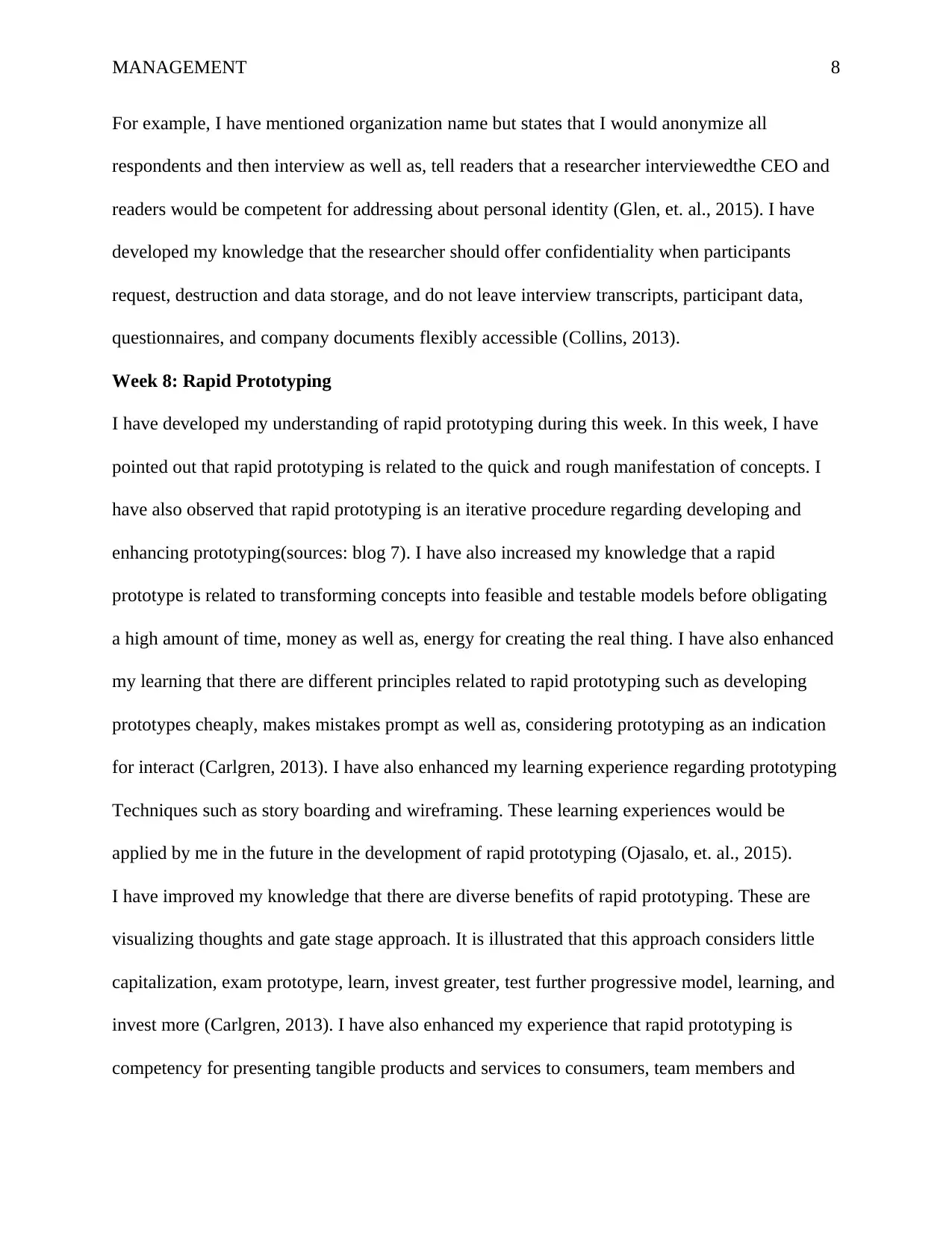
MANAGEMENT 8
For example, I have mentioned organization name but states that I would anonymize all
respondents and then interview as well as, tell readers that a researcher interviewedthe CEO and
readers would be competent for addressing about personal identity (Glen, et. al., 2015). I have
developed my knowledge that the researcher should offer confidentiality when participants
request, destruction and data storage, and do not leave interview transcripts, participant data,
questionnaires, and company documents flexibly accessible (Collins, 2013).
Week 8: Rapid Prototyping
I have developed my understanding of rapid prototyping during this week. In this week, I have
pointed out that rapid prototyping is related to the quick and rough manifestation of concepts. I
have also observed that rapid prototyping is an iterative procedure regarding developing and
enhancing prototyping(sources: blog 7). I have also increased my knowledge that a rapid
prototype is related to transforming concepts into feasible and testable models before obligating
a high amount of time, money as well as, energy for creating the real thing. I have also enhanced
my learning that there are different principles related to rapid prototyping such as developing
prototypes cheaply, makes mistakes prompt as well as, considering prototyping as an indication
for interact (Carlgren, 2013). I have also enhanced my learning experience regarding prototyping
Techniques such as story boarding and wireframing. These learning experiences would be
applied by me in the future in the development of rapid prototyping (Ojasalo, et. al., 2015).
I have improved my knowledge that there are diverse benefits of rapid prototyping. These are
visualizing thoughts and gate stage approach. It is illustrated that this approach considers little
capitalization, exam prototype, learn, invest greater, test further progressive model, learning, and
invest more (Carlgren, 2013). I have also enhanced my experience that rapid prototyping is
competency for presenting tangible products and services to consumers, team members and
For example, I have mentioned organization name but states that I would anonymize all
respondents and then interview as well as, tell readers that a researcher interviewedthe CEO and
readers would be competent for addressing about personal identity (Glen, et. al., 2015). I have
developed my knowledge that the researcher should offer confidentiality when participants
request, destruction and data storage, and do not leave interview transcripts, participant data,
questionnaires, and company documents flexibly accessible (Collins, 2013).
Week 8: Rapid Prototyping
I have developed my understanding of rapid prototyping during this week. In this week, I have
pointed out that rapid prototyping is related to the quick and rough manifestation of concepts. I
have also observed that rapid prototyping is an iterative procedure regarding developing and
enhancing prototyping(sources: blog 7). I have also increased my knowledge that a rapid
prototype is related to transforming concepts into feasible and testable models before obligating
a high amount of time, money as well as, energy for creating the real thing. I have also enhanced
my learning that there are different principles related to rapid prototyping such as developing
prototypes cheaply, makes mistakes prompt as well as, considering prototyping as an indication
for interact (Carlgren, 2013). I have also enhanced my learning experience regarding prototyping
Techniques such as story boarding and wireframing. These learning experiences would be
applied by me in the future in the development of rapid prototyping (Ojasalo, et. al., 2015).
I have improved my knowledge that there are diverse benefits of rapid prototyping. These are
visualizing thoughts and gate stage approach. It is illustrated that this approach considers little
capitalization, exam prototype, learn, invest greater, test further progressive model, learning, and
invest more (Carlgren, 2013). I have also enhanced my experience that rapid prototyping is
competency for presenting tangible products and services to consumers, team members and
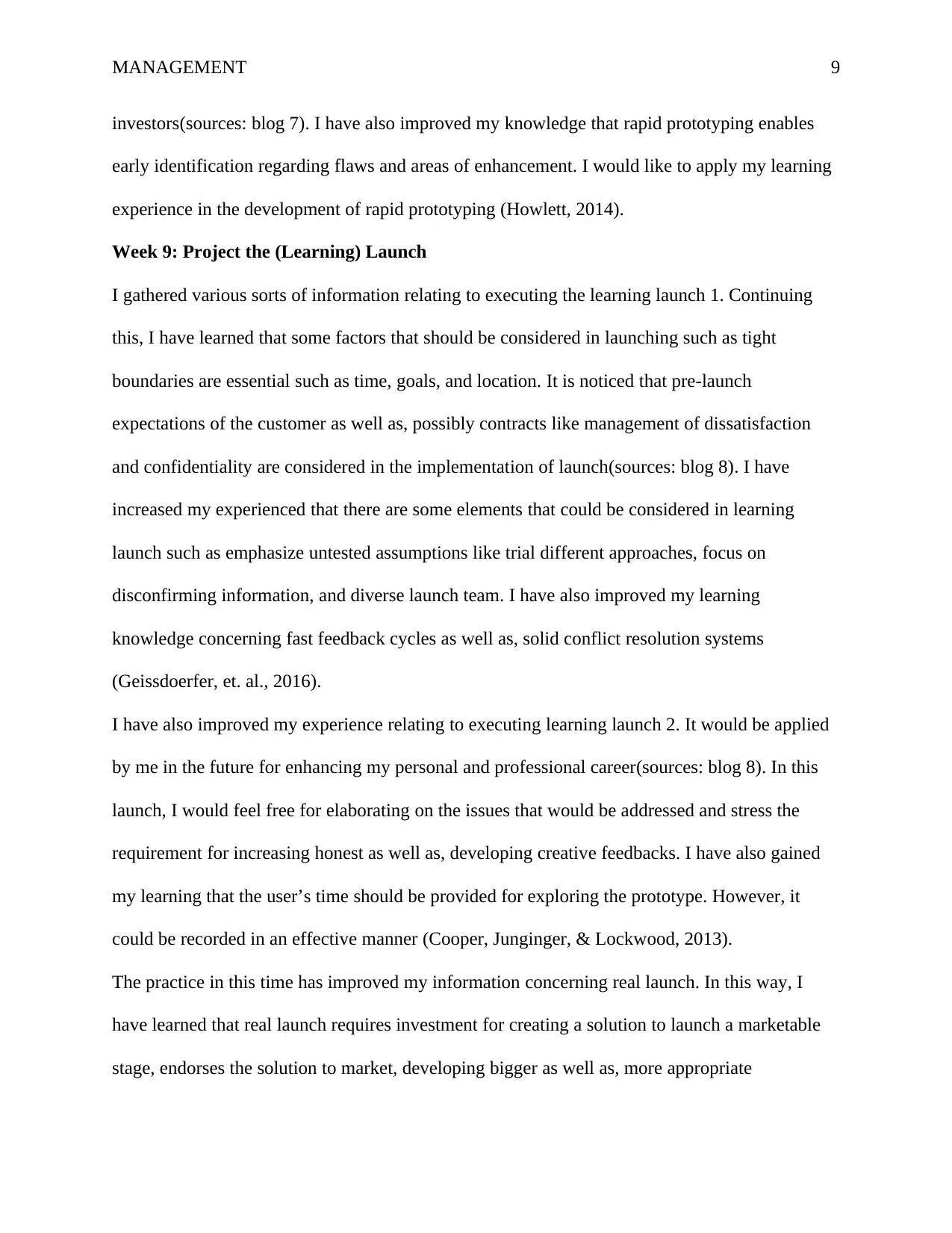
MANAGEMENT 9
investors(sources: blog 7). I have also improved my knowledge that rapid prototyping enables
early identification regarding flaws and areas of enhancement. I would like to apply my learning
experience in the development of rapid prototyping (Howlett, 2014).
Week 9: Project the (Learning) Launch
I gathered various sorts of information relating to executing the learning launch 1. Continuing
this, I have learned that some factors that should be considered in launching such as tight
boundaries are essential such as time, goals, and location. It is noticed that pre-launch
expectations of the customer as well as, possibly contracts like management of dissatisfaction
and confidentiality are considered in the implementation of launch(sources: blog 8). I have
increased my experienced that there are some elements that could be considered in learning
launch such as emphasize untested assumptions like trial different approaches, focus on
disconfirming information, and diverse launch team. I have also improved my learning
knowledge concerning fast feedback cycles as well as, solid conflict resolution systems
(Geissdoerfer, et. al., 2016).
I have also improved my experience relating to executing learning launch 2. It would be applied
by me in the future for enhancing my personal and professional career(sources: blog 8). In this
launch, I would feel free for elaborating on the issues that would be addressed and stress the
requirement for increasing honest as well as, developing creative feedbacks. I have also gained
my learning that the user’s time should be provided for exploring the prototype. However, it
could be recorded in an effective manner (Cooper, Junginger, & Lockwood, 2013).
The practice in this time has improved my information concerning real launch. In this way, I
have learned that real launch requires investment for creating a solution to launch a marketable
stage, endorses the solution to market, developing bigger as well as, more appropriate
investors(sources: blog 7). I have also improved my knowledge that rapid prototyping enables
early identification regarding flaws and areas of enhancement. I would like to apply my learning
experience in the development of rapid prototyping (Howlett, 2014).
Week 9: Project the (Learning) Launch
I gathered various sorts of information relating to executing the learning launch 1. Continuing
this, I have learned that some factors that should be considered in launching such as tight
boundaries are essential such as time, goals, and location. It is noticed that pre-launch
expectations of the customer as well as, possibly contracts like management of dissatisfaction
and confidentiality are considered in the implementation of launch(sources: blog 8). I have
increased my experienced that there are some elements that could be considered in learning
launch such as emphasize untested assumptions like trial different approaches, focus on
disconfirming information, and diverse launch team. I have also improved my learning
knowledge concerning fast feedback cycles as well as, solid conflict resolution systems
(Geissdoerfer, et. al., 2016).
I have also improved my experience relating to executing learning launch 2. It would be applied
by me in the future for enhancing my personal and professional career(sources: blog 8). In this
launch, I would feel free for elaborating on the issues that would be addressed and stress the
requirement for increasing honest as well as, developing creative feedbacks. I have also gained
my learning that the user’s time should be provided for exploring the prototype. However, it
could be recorded in an effective manner (Cooper, Junginger, & Lockwood, 2013).
The practice in this time has improved my information concerning real launch. In this way, I
have learned that real launch requires investment for creating a solution to launch a marketable
stage, endorses the solution to market, developing bigger as well as, more appropriate
⊘ This is a preview!⊘
Do you want full access?
Subscribe today to unlock all pages.

Trusted by 1+ million students worldwide
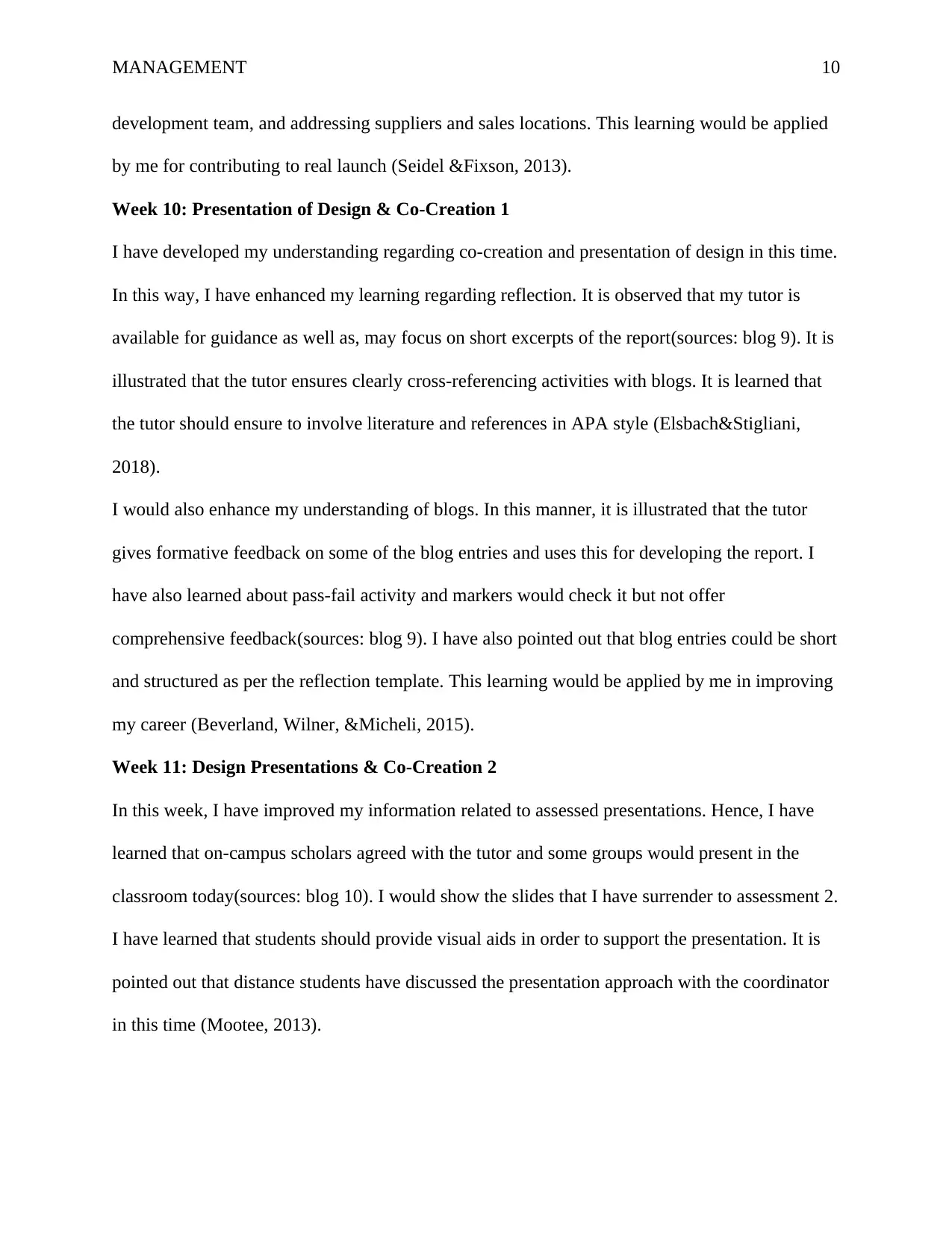
MANAGEMENT 10
development team, and addressing suppliers and sales locations. This learning would be applied
by me for contributing to real launch (Seidel &Fixson, 2013).
Week 10: Presentation of Design & Co-Creation 1
I have developed my understanding regarding co-creation and presentation of design in this time.
In this way, I have enhanced my learning regarding reflection. It is observed that my tutor is
available for guidance as well as, may focus on short excerpts of the report(sources: blog 9). It is
illustrated that the tutor ensures clearly cross-referencing activities with blogs. It is learned that
the tutor should ensure to involve literature and references in APA style (Elsbach&Stigliani,
2018).
I would also enhance my understanding of blogs. In this manner, it is illustrated that the tutor
gives formative feedback on some of the blog entries and uses this for developing the report. I
have also learned about pass-fail activity and markers would check it but not offer
comprehensive feedback(sources: blog 9). I have also pointed out that blog entries could be short
and structured as per the reflection template. This learning would be applied by me in improving
my career (Beverland, Wilner, &Micheli, 2015).
Week 11: Design Presentations & Co-Creation 2
In this week, I have improved my information related to assessed presentations. Hence, I have
learned that on-campus scholars agreed with the tutor and some groups would present in the
classroom today(sources: blog 10). I would show the slides that I have surrender to assessment 2.
I have learned that students should provide visual aids in order to support the presentation. It is
pointed out that distance students have discussed the presentation approach with the coordinator
in this time (Mootee, 2013).
development team, and addressing suppliers and sales locations. This learning would be applied
by me for contributing to real launch (Seidel &Fixson, 2013).
Week 10: Presentation of Design & Co-Creation 1
I have developed my understanding regarding co-creation and presentation of design in this time.
In this way, I have enhanced my learning regarding reflection. It is observed that my tutor is
available for guidance as well as, may focus on short excerpts of the report(sources: blog 9). It is
illustrated that the tutor ensures clearly cross-referencing activities with blogs. It is learned that
the tutor should ensure to involve literature and references in APA style (Elsbach&Stigliani,
2018).
I would also enhance my understanding of blogs. In this manner, it is illustrated that the tutor
gives formative feedback on some of the blog entries and uses this for developing the report. I
have also learned about pass-fail activity and markers would check it but not offer
comprehensive feedback(sources: blog 9). I have also pointed out that blog entries could be short
and structured as per the reflection template. This learning would be applied by me in improving
my career (Beverland, Wilner, &Micheli, 2015).
Week 11: Design Presentations & Co-Creation 2
In this week, I have improved my information related to assessed presentations. Hence, I have
learned that on-campus scholars agreed with the tutor and some groups would present in the
classroom today(sources: blog 10). I would show the slides that I have surrender to assessment 2.
I have learned that students should provide visual aids in order to support the presentation. It is
pointed out that distance students have discussed the presentation approach with the coordinator
in this time (Mootee, 2013).
Paraphrase This Document
Need a fresh take? Get an instant paraphrase of this document with our AI Paraphraser
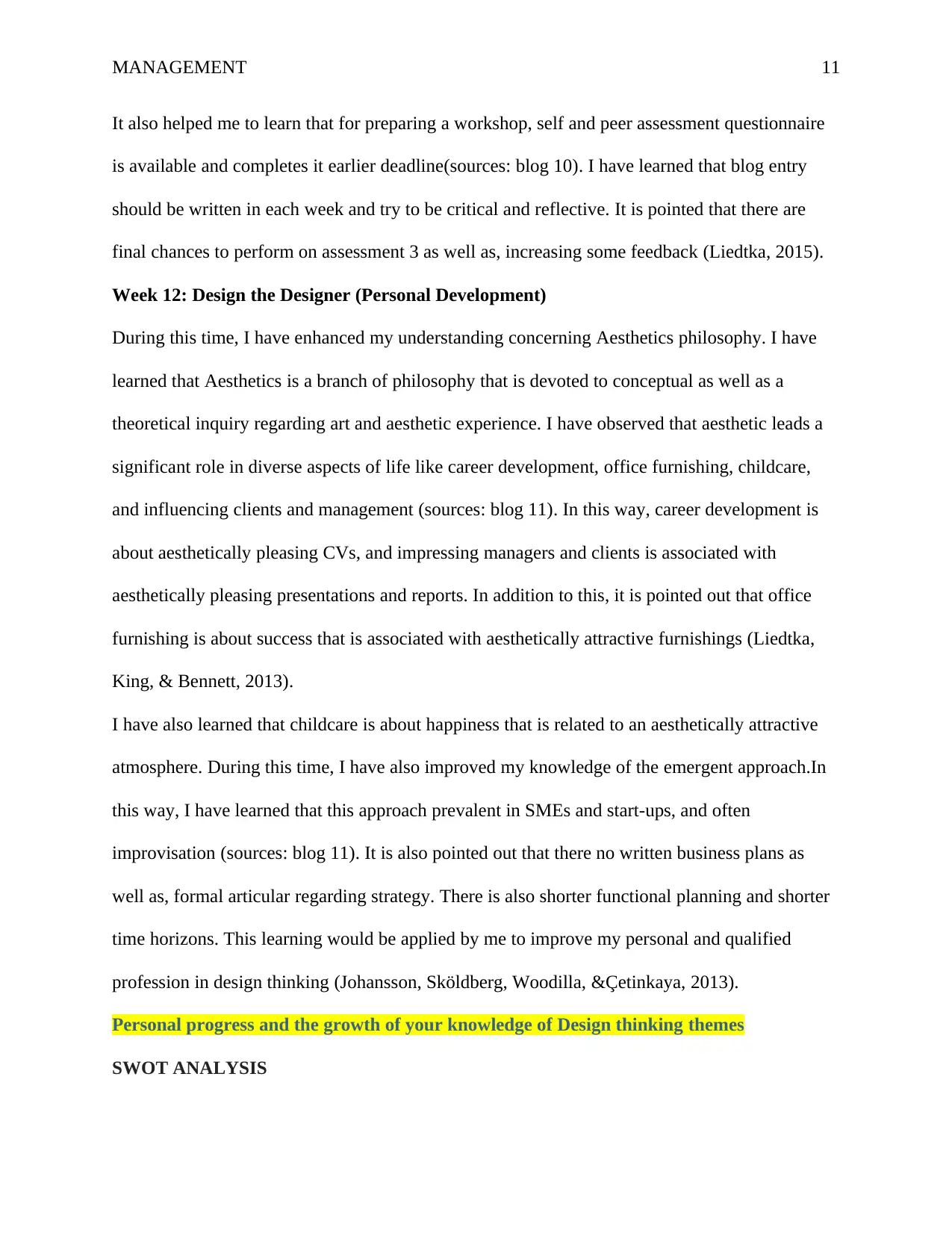
MANAGEMENT 11
It also helped me to learn that for preparing a workshop, self and peer assessment questionnaire
is available and completes it earlier deadline(sources: blog 10). I have learned that blog entry
should be written in each week and try to be critical and reflective. It is pointed that there are
final chances to perform on assessment 3 as well as, increasing some feedback (Liedtka, 2015).
Week 12: Design the Designer (Personal Development)
During this time, I have enhanced my understanding concerning Aesthetics philosophy. I have
learned that Aesthetics is a branch of philosophy that is devoted to conceptual as well as a
theoretical inquiry regarding art and aesthetic experience. I have observed that aesthetic leads a
significant role in diverse aspects of life like career development, office furnishing, childcare,
and influencing clients and management (sources: blog 11). In this way, career development is
about aesthetically pleasing CVs, and impressing managers and clients is associated with
aesthetically pleasing presentations and reports. In addition to this, it is pointed out that office
furnishing is about success that is associated with aesthetically attractive furnishings (Liedtka,
King, & Bennett, 2013).
I have also learned that childcare is about happiness that is related to an aesthetically attractive
atmosphere. During this time, I have also improved my knowledge of the emergent approach.In
this way, I have learned that this approach prevalent in SMEs and start-ups, and often
improvisation (sources: blog 11). It is also pointed out that there no written business plans as
well as, formal articular regarding strategy. There is also shorter functional planning and shorter
time horizons. This learning would be applied by me to improve my personal and qualified
profession in design thinking (Johansson, Sköldberg, Woodilla, &Çetinkaya, 2013).
Personal progress and the growth of your knowledge of Design thinking themes
SWOT ANALYSIS
It also helped me to learn that for preparing a workshop, self and peer assessment questionnaire
is available and completes it earlier deadline(sources: blog 10). I have learned that blog entry
should be written in each week and try to be critical and reflective. It is pointed that there are
final chances to perform on assessment 3 as well as, increasing some feedback (Liedtka, 2015).
Week 12: Design the Designer (Personal Development)
During this time, I have enhanced my understanding concerning Aesthetics philosophy. I have
learned that Aesthetics is a branch of philosophy that is devoted to conceptual as well as a
theoretical inquiry regarding art and aesthetic experience. I have observed that aesthetic leads a
significant role in diverse aspects of life like career development, office furnishing, childcare,
and influencing clients and management (sources: blog 11). In this way, career development is
about aesthetically pleasing CVs, and impressing managers and clients is associated with
aesthetically pleasing presentations and reports. In addition to this, it is pointed out that office
furnishing is about success that is associated with aesthetically attractive furnishings (Liedtka,
King, & Bennett, 2013).
I have also learned that childcare is about happiness that is related to an aesthetically attractive
atmosphere. During this time, I have also improved my knowledge of the emergent approach.In
this way, I have learned that this approach prevalent in SMEs and start-ups, and often
improvisation (sources: blog 11). It is also pointed out that there no written business plans as
well as, formal articular regarding strategy. There is also shorter functional planning and shorter
time horizons. This learning would be applied by me to improve my personal and qualified
profession in design thinking (Johansson, Sköldberg, Woodilla, &Çetinkaya, 2013).
Personal progress and the growth of your knowledge of Design thinking themes
SWOT ANALYSIS
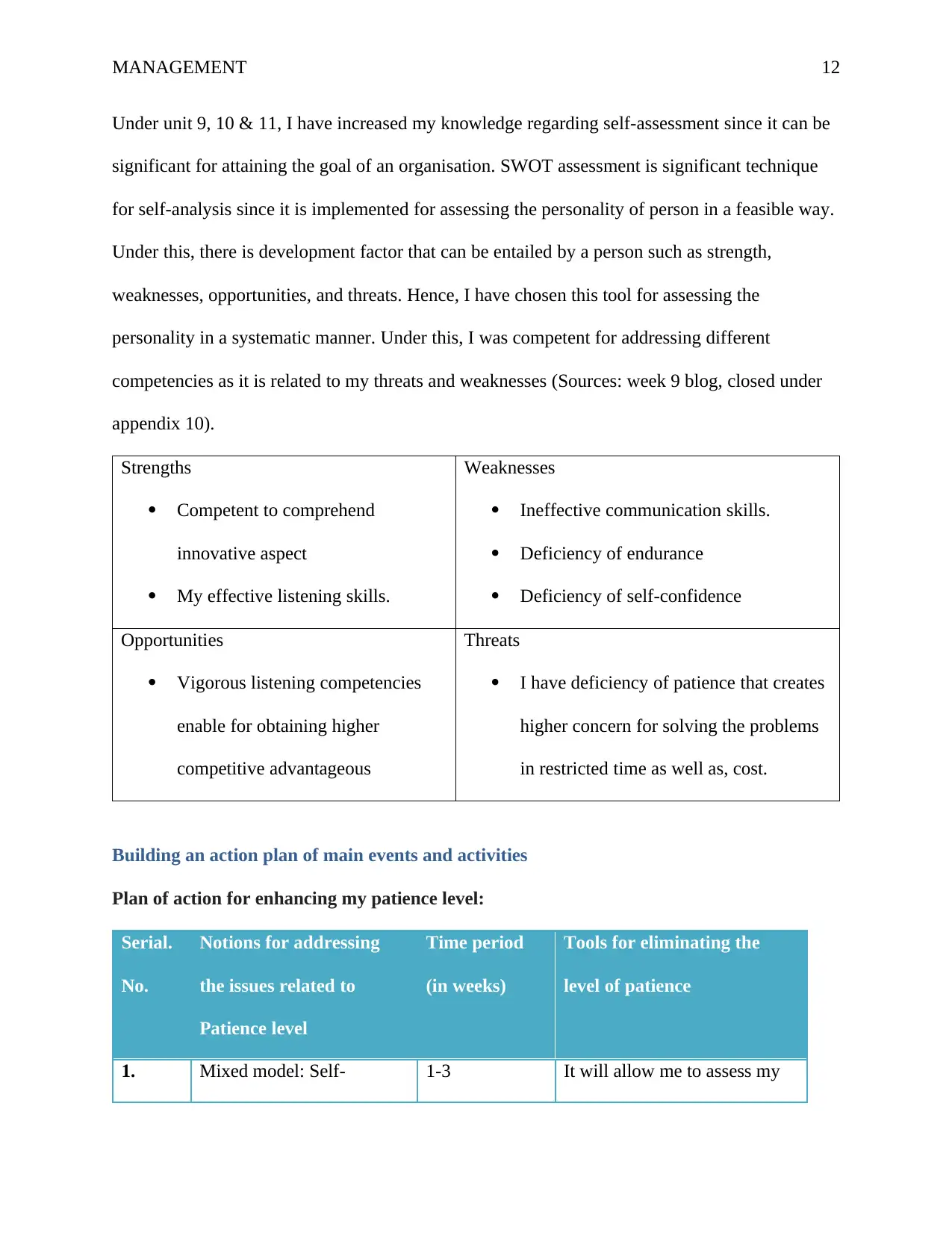
MANAGEMENT 12
Under unit 9, 10 & 11, I have increased my knowledge regarding self-assessment since it can be
significant for attaining the goal of an organisation. SWOT assessment is significant technique
for self-analysis since it is implemented for assessing the personality of person in a feasible way.
Under this, there is development factor that can be entailed by a person such as strength,
weaknesses, opportunities, and threats. Hence, I have chosen this tool for assessing the
personality in a systematic manner. Under this, I was competent for addressing different
competencies as it is related to my threats and weaknesses (Sources: week 9 blog, closed under
appendix 10).
Strengths
Competent to comprehend
innovative aspect
My effective listening skills.
Weaknesses
Ineffective communication skills.
Deficiency of endurance
Deficiency of self-confidence
Opportunities
Vigorous listening competencies
enable for obtaining higher
competitive advantageous
Threats
I have deficiency of patience that creates
higher concern for solving the problems
in restricted time as well as, cost.
Building an action plan of main events and activities
Plan of action for enhancing my patience level:
Serial.
No.
Notions for addressing
the issues related to
Patience level
Time period
(in weeks)
Tools for eliminating the
level of patience
1. Mixed model: Self- 1-3 It will allow me to assess my
Under unit 9, 10 & 11, I have increased my knowledge regarding self-assessment since it can be
significant for attaining the goal of an organisation. SWOT assessment is significant technique
for self-analysis since it is implemented for assessing the personality of person in a feasible way.
Under this, there is development factor that can be entailed by a person such as strength,
weaknesses, opportunities, and threats. Hence, I have chosen this tool for assessing the
personality in a systematic manner. Under this, I was competent for addressing different
competencies as it is related to my threats and weaknesses (Sources: week 9 blog, closed under
appendix 10).
Strengths
Competent to comprehend
innovative aspect
My effective listening skills.
Weaknesses
Ineffective communication skills.
Deficiency of endurance
Deficiency of self-confidence
Opportunities
Vigorous listening competencies
enable for obtaining higher
competitive advantageous
Threats
I have deficiency of patience that creates
higher concern for solving the problems
in restricted time as well as, cost.
Building an action plan of main events and activities
Plan of action for enhancing my patience level:
Serial.
No.
Notions for addressing
the issues related to
Patience level
Time period
(in weeks)
Tools for eliminating the
level of patience
1. Mixed model: Self- 1-3 It will allow me to assess my
⊘ This is a preview!⊘
Do you want full access?
Subscribe today to unlock all pages.

Trusted by 1+ million students worldwide
1 out of 22
Related Documents
Your All-in-One AI-Powered Toolkit for Academic Success.
+13062052269
info@desklib.com
Available 24*7 on WhatsApp / Email
![[object Object]](/_next/static/media/star-bottom.7253800d.svg)
Unlock your academic potential
Copyright © 2020–2025 A2Z Services. All Rights Reserved. Developed and managed by ZUCOL.

